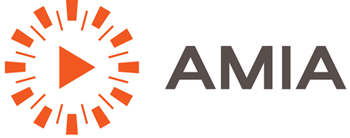AMIA 2016 Presentations
Speaker presentations are posted as they are received.
- Program Stream: DigiPres: AV Content and Digital Preservation
- Program Stream: Environmental Issues and Archives
- Program Stream: Framing the Horizon: What’s Next in Moving Image Archival Education
- Program Stream: Do It Yourself & Community Archiving
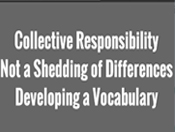 Plenary | Action for Diversity, Inclusion, and Equity in AMIA
Plenary | Action for Diversity, Inclusion, and Equity in AMIA
Moriah Ulinskas, University of California, Santa Barbara
Jacqueline Stewart, University of Chicago, Cinema and Media Studies
Brian Graney, Indiana University Bloomington
Mark A Puente, Association of Research Libraries
Janet Ceja, Simmons College, School of Library and Information Science
Carmel Curtis, United Nations
This opening plenary is an opportunity for AMIA members to learn about ambitious diversity programs at related professional associations, and ways in which moving image archivists can impact the field when issues of diversity and inclusion are prioritized in their work. Attendees will hear from recipients of the IMLS-funded Mosaic Program (ARL/SAA), and the Spectrum Doctoral Fellowship Program (ALA/University of Pittsburgh) and are intended to engage in a consideration of AMIA’s history and goals regarding diversity. This plenary seeks to catalyze actionable goals which can promote the diversification of AMIA membership, activities, and the moving image archiving and preservation field at large.
_________________________________

DigiPres 101 Workshop: Programming Basics and Preservation Tools
Carla Arton, IU Libraries Moving Image Archive
Ashley Blewer, New York Public Library
Erwin Verbruggen, Netherlands Sound and Vision
Reto Kromer, AV Preservation by reto.ch
Kara Van Malssen, AVPreserve
Ben Turkus, Bay Area Video Coalition
Dave Rice, CUNY Television
Reto Kromer, AV Preservation by reto.ch
Sarah Romkey, artefactual
Through a combination of instruction, question and answer sessions, and hands on practical experience this workshop will give attendees a broad overview of the diverse range of open source tools used in digital preservation. The workshop will be broken up into two parts which can be enrolled in separately or as one full day workshop. Topics and tools covered in Part 1 include Command Line Basics, technical writing, GitHub, and MediaConch/MediaInfo. Part 2 will include FFmpeg, QCTools, and Archivematica.
- Pre-Conference Prep: Installation Guidelines and Prep
- Command Line Basics
- Technical Writing and Github
- MediaConch
- FFmpeg | FFmpeg Commands
- QCTools
- Intro to Archivematica
- Download from Google Drive
_________________________________
 Acknowledge: Energy Resources Status Check
Acknowledge: Energy Resources Status Check
Caroline Yeager, George Eastman Museum
Eric Hittinger, Rochester Institute of Technology
Human dependency on non-renewable fossil fuels has reached a critical point. Moving image archivists need to consider how to preserve moving image collections with lower dependence on fossil fuels or their derivative products by considering alternative energy solutions. This panel will address current understandings of the availability of fossil fuels, their negative effect on our environment, and discuss the emerging alternative technologies that are a critical part of our energy transition.
- Presentation: Caroline Yeager, George Eastman Museum
- Presentation: Eric Hittinger, Rochester Institute of Technology
_________________________________
 Acknowledge/Adapt: Environmental Impact of Archiving
Acknowledge/Adapt: Environmental Impact of Archiving
Linda Tadic, Digital Bedrock
The materials and products we use to preserve moving image and digital collections may seem benign, but they may also have unintended and detrimental effects on our environment. This panel looks at current practices, products, and technologies in moving image and digital archiving that are, or can be, potentially dangerous to humans and the environment. What alternatives are there?
_________________________________
 Acknowledge: Global Climate Change
Acknowledge: Global Climate Change
Gloria Diez, ASAECA (Argentine Association of Film and Audiovisual Studies)
Casey Davis Kaufman, WGBH, Project ARCC
Raymond G. Najjar, Jr., Pennsylvania State University, Department of Meteorology and Atmospheric Science
Global climate change is producing rising tides, disastrous and increasingly extreme weather patterns, and placing moving image collections at risk. What can we as moving image archivists, do about it? This panel will address the global climate change issue from both a scientific standpoint as well as how it directly affects the archiving of films and digital media.
- Presentation: Casey Davis Kaufman, WGBH, Project ARCC
- Presentation: Raymond G. Najjar, Jr., Pennsylvania State University
_________________________________
 Adapt/Survive: Outside the Box Energy & Conservation Policies, Practices and Methods
Adapt/Survive: Outside the Box Energy & Conservation Policies, Practices and Methods
Caroline Yeager, George Eastman Museum
Jeremy Linden, Image Permanence Institute
Reto Kromer, AV Preservation by reto.ch
Mick Newnham, NFSA
New solutions to old problems is the focus of this panel. It looks at sustainable building design for archives and conservation centers, and seeks inventive ideas to re-think film and digital conservation to make it truly sustainable.
_________________________________
 Adapt/Survive: Advocating for the Survival of Moving Image Collections
Adapt/Survive: Advocating for the Survival of Moving Image Collections
Ray Edmondson, Archive Associates
Eira Tansey, University of Cincinnati
Environmental disasters extract enormous tolls on any community: we are devastated emotionally, physically, and financially. This panel seeks to address ways in which moving image archivists can speak to their institutions, communities and governments to ensure that the collections they care for – repositories of our cultural memory – remain open and active for the common good.
_________________________________
 Capturing Captioning: Problems in Preservation and Presentation of Timed Text
Capturing Captioning: Problems in Preservation and Presentation of Timed Text
Kimberly Tarr, New York University Libraries
Michael Grant, New York University Libraries
Lauren Alberque , RIT Libraries
Carleton L. Jackson, UMD Libraries
Developed in the 1970s as a method for providing expanded access to television programming for the hearing-impaired, closed captions (CC) are carried in line 21 of the NTSC video signal. When analog video is converted to an uncompressed digital file, closed captions are preserved. They can, however, become scrambled when compression is introduced, which presents a key challenge to institutions interested in preserving CC functionality in access copies of preserved video. This panel explores three institutions’ CC struggles and solutions in preserving video collections, serving a large base of deaf and blind users, and handling CC in library streaming. This session will focus on the technical issues including transfer workflows, hardware and software considerations, and creating access copies both in-house and with a vendor. Lastly, the session aims to broaden the moving image archival community’s interpretation of access.
- Presentation: Kimberly Tarr, New York University Libraries
- Presentation: Michael Grant, New York University Libraries
- Presentation: Lauren Alberque, RIT Libraries
_________________________________
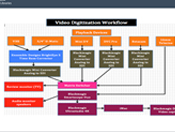
Digital Preservation for the Rest of Us — Adapting Best Practices on a Shoestring Budget
Rachel Mattson, La MaMa Archives
Tim Babcock, Penn State University
Dorothea Salo, University of Wisconsin-Madison
This presentation provides a path forward for organizations or individuals who are pursuing digital preservation with limited resources. Speakers provide context for their decisions regarding preservation and provide attendees with an idea of how to move forward with preservation initiatives in manageable ways.
_________________________________
 Documenting Provenance: Out of Our Heads and into the Database
Documenting Provenance: Out of Our Heads and into the Database
Mike Brostoff, Academy Film Archive
Stephen Danley, Academy Film Archive
Stephanie Sapienza, Maryland Institute of Technology in the Humanitites
Provenance is one of the primary tenets of the archival profession. Yet when cataloging moving images, the focus tends to be on item and content level description, while the collections’ provenance and significance remains in staff members’ heads, personal filing systems or as unasked questions. Often paper resources accompanying a moving image collection remain segregated without any attempt to intellectually integrate them. In this panel discussion, Mike Brostoff and Stephen Danley will discuss the structure and workflows the Academy Film Archive developed to organize staff into collection teams with the goal of documenting collection level provenance and other related contextual information. Stephanie Sapienza will then lead a demonstration about how contextual paper documentation can enhance understanding of related media collections, using some examples from current and developing projects.
_________________________________
 Digitization and Reassembly of Eyes on the Prize Interviews
Digitization and Reassembly of Eyes on the Prize Interviews
Nadia Ghasedi, Washington University
Emily Halevy, Crawford Media Services, Inc.
Jim Hone, Washington University
Irene Taylor, Washington University
Regarded as the definitive work on the Civil Rights Movement, the documentary series, Eyes on the Prize, has been seen by millions since its PBS debut in 1987. However, what remains unseen is the nearly 85 hours of interview outtakes that provide further insight into the series’ original stories of struggle, resistance, and perseverance. Through the Eyes on the Prize Digitization and Reassembly project, funded by the National Historical Publications and Records Commission, Washington University Libraries is making the complete, never-before-seen interviews and synchronized transcripts freely accessible through its newly developed Hydra digital repository. Crawford Media Services, Inc. completed the digitization and the digital reassembly was completed in-house. This session will provide both archivist and vendor insights into planning, workflow management, and the related challenges of implementing large-scale digitization projects.eyes-on-the-prizeeyes-on-the-prize
________________________________
 Managing Bodycam Video: Challenges, Needs and New Approaches
Managing Bodycam Video: Challenges, Needs and New Approaches
Snowden Becker, UCLA Department of Information Studies
Clarence Trapp, Pittsburgh Police Department
This session will share preliminary results from a summer 2016 IMLS funded National Forum meeting focused on data management needs arising from large scale video recording programs, and explore how those needs manifest in the Pittsburgh Police Department’s own recently launched bodyworn camera program.
_________________________________
 From Mass Digitization to Description: Indiana University’s Strategy to Overcome the Next Great Challenge
From Mass Digitization to Description: Indiana University’s Strategy to Overcome the Next Great Challenge
Chris Lacinak, AVPreserve
Jon Dunn, Indiana University
Over the past decade much focus has been placed on mass digitization of legacy audiovisual collections. With progress on this front, today there is a new focus emerging: mass description. In 2014 Indiana University (IU) began an effort to digitize hundreds of thousands of hours of audiovisual materials from across campus, leading to the challenge of describing this extraordinarily diverse set of materials both at scale and at a sufficient level of granularity to enable meaningful and effective discovery. In 2015, with the support of AVPreserve, IU began a strategic planning project to research, analyze and report on technologies, workflows, staffing, timeline and budgets to address this challenge. With presentations from Jon Dunn and Chris Lacinak this session will offer insights into the leading-edge work occurring at IU and present some of the newest technologies and workflows available for rich description of, and improved access to audiovisual collections.
_________________________________
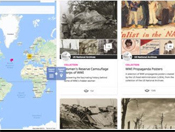 The National Archives, Historypin, and WWI: Anniversaries, Apps, and Audiences
The National Archives, Historypin, and WWI: Anniversaries, Apps, and Audiences
Christina Kovac, National Archives and Records Administration (NARA)
Kerri Young, Historypin
Almost two years ago, NARA and Historypin launched a project to digitize the largest this content to multiple audiences, NARA is launching an app to deliver moving images and photos to museums, teachers, and coders. Come learn about the process we followed and the app we’ve built!
- Session Handout
- Presentation to come
_________________________________
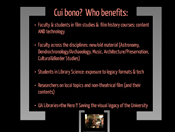 The New Old Curriculum: Why 20th Century Archiving Techniques Matter in the 21st Century
The New Old Curriculum: Why 20th Century Archiving Techniques Matter in the 21st Century
Lily Troia, College of William and Mary
Dino Everett, University of Southern California
Tara Kelley, Rutgers University
Alexander Whelan, Pratt Institute
Jennifer Jenkins, Arizona University
This session addresses the need to incorporate film-related skills and best practices into formal archive education curricula. These skills, rather than being minor or specialist in nature, are crucial to success in professional moving image archiving: every archive has or works with film! By developing skills in film handling, preservation, conservation and appreciation, students, as emerging professionals, can confidently address the needs of an archive’s film holdings without having to secure an outside vendor. Sponsored by the AMIA Film Advocacy Task Force.
_________________________________
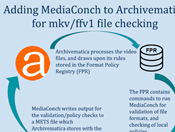 Poster: Archivematica-MediaConch Integration
Poster: Archivematica-MediaConch Integration
Sarah Romkey, Artefactual Systems
This poster will describe the process the of designing and implementing an integration between Archivematica, an open-source digital preservation platform, and MediaConch, an implementation checker, policy checker and reporter for Matroska, FFV1 and PCM files. This integration is currently in progress by Artefactual Systems, lead developer of Archivematica, in partnership with MediaArea, developers of MediaConch, and funded by the PREFORMA project. The poster will discuss use cases and workflows for using MediaConch as a micro-service tool within Archivematica, including format conformance and policy checking.
_________________________________
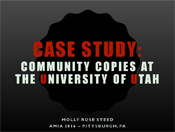
Real Talk: Archiving Independent Media and Community Collections
Molly Fair, Chair
Kelly Haydon, Bay Area Video Coalition
Keith Wilson , People’s Archive of Police Violence
Carol Steiner , People’s Archive of Police Violence
Caroline Gil, Independent Archivist
Skyla Hearn, DuSable Museum of African American History
Accepted standards and best practices for audiovisual archiving usually emerge from institutional contexts (e.g. libraries, universities, professional organizations), and are not always applicable or sufficient when working with community-based groups or alternative media-makers. How do archivists working in traditional institutions foster more reciprocal and collaborative relationships with communities to preserve their histories? What are the affective, emotional, or other social dynamics involved with archiving documentation of police violence? What are some lessons learned from participatory approaches to archiving the work of independent artists and the collections of grassroots media distributors? This panel will examine the particular challenges of working in these contexts, and the practices that emerge from them.
- Session Recording
- Presentation: Molly Fair
- More recordings and information from the Do It Yourself & Community Archiving Program
_________________________________
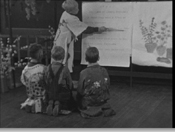 Re-Envisioning Japan: Ephemeral Film Recuperation, Restoration, and Digital Curation
Re-Envisioning Japan: Ephemeral Film Recuperation, Restoration, and Digital Curation
Joanne Bernardi, University of Rochester
Nora Dimmock, University of Rochester
Josh Romphf, University of Rochester
“Re-Envisioning Japan: Japan as Destination in Visual and Material Culture” (REJ) is a multimedia digital archive of tourism, travel and educational ephemera documenting changing images of Japan and its place in the world in the early to mid 20th century. The recuperation and digital presentation of small gauge ephemeral films in context is a key objective of this collaborative project between faculty and library staff at the University of Rochester. Now in its 5th year as a large-scale, ongoing project, REJ had humble beginnings. It is a useful case study for colleagues similarly working at the intersection of academic and archival practice. Topics include the creative digital curation of ephemeral films for research, teaching, and general interest, the innovative use of open-source tools for digitally restoring and presenting films, and solutions for successfully planning and developing similar projects in the context of a library digital humanities center.
_________________________________
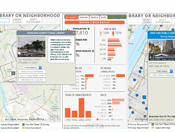 DigiPres: Theory vs. Practice
DigiPres: Theory vs. Practice
Tom De Smet, Netherlands Institute for Sound & Vision
Dinah Handel, New York Public Library
Travis Wagner, University of South Carolina
Jana Grazley City of Vancouver Archives
Mary Kidd New York Public Library
This presentation addresses the sometimes stark divide between the theory and practice of digital preservation. Panelists will speak about the often vast distance between standards and reality of enacting those standards
- Presentation: Dinah Handel, New York Public Library/Travis Wagner, University of South Carolina
- Notes: Dinah Handel, New York Public Library/Travis Wagner, University of South Carolina
- Presentations from Dinah Handel via GitHub
_________________________________
 Tech in Community, Community in Tech: Digital Collections in the Real World
Tech in Community, Community in Tech: Digital Collections in the Real World
Lauren Sorensen, UCLA
Rachel Mattson , La MaMa Archives
Nicole Martin , Human Rights Watch
Dinah Handel , New York Public Library
Kristin Lipska California Audiovisual Preservation Project (CAVPP)
From receiving digitized video files back from vendors, to bash shell scripting, archivists are frequently finding themselves as the technology leads of their underfunded departments, or newly managing contractors for technology projects. This session will introduce some software programs that archivists have used to make their lives easier, and discuss strategies for taking the fear out of technology in the archives. Panelists will introduce a handful of tools and scripts that help facilitate different areas of a digital collections’ lifecycle, as well as discussing workplace matters and experiences in the field.
- Session Recording
- Presentation: Kristin Lipska, CAVPP
- Presentation: Dinah Handel, New York Public Library
- More recordings and information from the Do It Yourself & Community Archiving Program
_________________________________
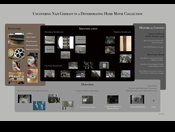 Poster: Uncovering Nazi Germany in a Deteriorating Home Movie Collection
Poster: Uncovering Nazi Germany in a Deteriorating Home Movie Collection
Jen O’Leary, UCLA MIAS Student
As a student in Snowden Becker’s UCLA MIAS Home Movie class, a group of us were tasked with processing a collection of films loaned to us by UCLA History Department staff member Ann Major. Upon opening the box of films she had given us, we were struck with the distinct smell of vinegar syndrome, and greeted with reels that had been fused together and film that was coming apart in our hands. A few films, including those labeled as “Germany 1933” and “Germany 1934” proved to be in much better condition, and we inspected and digitized the films. Title cards describing “Hitlerjugend” and “Herr Hitler” followed by the Hitler Youth and Hitler himself in elaborate parades grabbed our attention, and upon further discussions with Ann Major, we learned that her grandfather had been on an academic assignment in Germany during the 1930s and these films were his travelogues, documenting his time in Europe. Our next challenge was to determine the future homes for the 42 reels of historically important deteriorating film. Other than the reels of film depicting Europe in the 1930s, the collection also included commencement footage from US colleges in the 1940s, and family vacations in New England in the 1950s. Due to the varied nature of the collection, we decided to divide up the films and donate them to specialized archives. Donation agreements are currently being negotiated with the United States Holocaust Memorial Museum, the Yale Film Study Center, and the Center for Home Movies.
_________________________________
 Poster: “Building With Service”: The Audiovisual Content of the Golden State Mutual Life Insurance Company
Poster: “Building With Service”: The Audiovisual Content of the Golden State Mutual Life Insurance Company
Shani Miller, UCLA Library
The UCLA Library is digitizing the audiovisual materials and photographs in the Golden State Mutual Life Insurance Company collection, with the goal of making these items more widely accessible to the public. When William J. Nickerson, Jr., George A. Beavers, Jr., and Norman O. Houston founded the company in 1925, few opportunities existed in the Los Angeles area for African American residents to purchase insurance, the result of discriminatory high rates or outright bans. Until it ceased operations in 2009, Golden State Mutual served as one of a few home-based Black insurance companies in Los Angeles. For more than eighty years, the company actively documented its corporate history as well as the broader history of African Americans in California through painting, sculpture, photography, and filmmaking. Among the highlights in the collection are 16mm films of the company’s annual picnics in 1947 and 1958, and a 1957 tour of the Home Office (designed by Paul R. Williams) featuring two special guests – Lena Horne and Joe Louis. This poster presentation offers as a preview of the moving image content and photographs in this historic collection.
_________________________________
